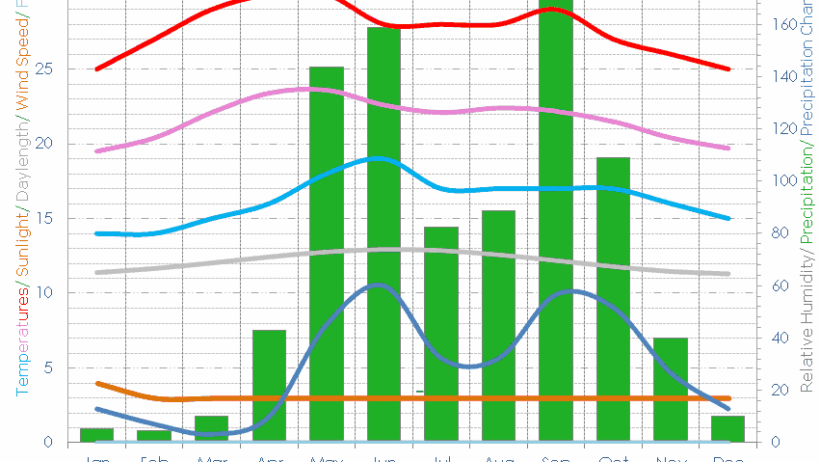Honduras, a verdant republic cradled in the heart of Central America, finds itself enveloped in the balmy embrace of tropical warmth. Its climate embodies the spirited pulse of a land steeped in biodiversity and cultural richness. The dynamic interplay between sunlit days and torrential rains shapes an ecosystem as diverse as its peoples and landscapes. Understanding this climatic tapestry is essential for appreciating both its splendor and its vulnerabilities.
At the core of Honduras’s climate is its tropical nature—an exquisite weave of warmth and moisture. The country encounters perpetual sunshine, where temperatures frequently soar above 30 degrees Celsius (86 degrees Fahrenheit) in many regions. This warmth, infused with the bracing influence of trade winds, renders Honduras a natural greenhouse, nurturing lush forests and vibrant flora. Yet, this balmy embrace does not come without its seasonal rhythms, most notably the principal rainy season from May to October. During these months, the climate transforms; Mother Nature unleashes her torrents, showering the land in a spectacular display of thunderstorms and cascading rains.
As one traverses the varied landscapes of Honduras, from the coastal shores of the Caribbean to the rugged highlands in the west, the climate intricacies become apparent. The coastal areas exude a sultry warmth, complemented by a refreshing sea breeze that temper the heat. Lakes such as Lake, Xolotlan are spectacles in their own right, with shimmering waters reflecting the sun—a mirage of tranquility amidst the dynamic climatic forces. Conversely, the mountainous regions experience a cooler gust, where the peaks reach into the heavens, often draped in ethereal mists. Here, the climate cradles a different narrative—one marked by temperate zones and distinct ecosystems, offering refuge to a multitude of species that thrive on the lower temperatures.
In these mountainous heights, the interplay of the altitudinal gradient plays a crucial role. Elevation alters not just the temperature but also the precipitation patterns, giving rise to several distinct microclimates. These microclimates are akin to a quilt stitched intricately by nature, where scattered pockets of unique habitats abound, fostering an incredible array of biodiversity. The cloud forests, shrouded in mist and mystery, create an enchanting ambiance that attracts both adventurers and scholars alike. Such areas teem with endemic species, thriving in the humid undergrowth and dappled sunlight, illustrating the delicate balance of life that climate diversity affords.
One cannot discuss the climate of Honduras without addressing the subtleties of its rainy seasons. During this annual cycle, the downpours are not merely a deluge but a lifeblood sustaining agriculture and ecosystems alike. Rainfall, concentrated primarily between June and September, revitalizes the land, transforming parched earth into vibrant tapestries of vegetation. The reawakening is profound; valleys resonate with a chorus of life, and flora bloom in jubilance, celebrating the liquid gold bestowed upon them.
However, the duality of nature becomes evident as this rainy season also has a darker side. The sheer intensity of storms can lead to devastating floods and landslides, a poignant reminder of the raw and unwavering power of climatic forces. Communities often face peril when deluges inundate localities that have little resilience to such natural calamities. This paradox underscores the need for sustainable practices, as a balance is sought between harnessing nature’s bounty and mitigating its potential wrath.
As the seasons ebb and flow, the climate in Honduras takes on an almost poetic quality. The transition from the ardent kiss of the sun to the gentle caress of rain parallels the rhythms of life itself. This cyclical nature, this ebb and flow of sunshine and precipitation, forms the heartbeat of Honduras, imbuing the landscape with vibrancy and life. The rituals of planting and harvest echo the rhythms of the seasons, engaging local communities in a dance as ancient as time—where survival and sustenance have long been intertwined with the climatic patterns.
Moreover, this climate is not merely a backdrop; it is an integral player in Honduras’s economic narrative. Agriculture flourishes here, with crops like coffee, bananas, and sugarcane dominating the economic landscape. The fertile soil—an effusion of minerals—aided by the seasonal rains, cultivates not just sustenance but also vital export goods that shape the nation’s economy. Yet, reliance on this bounty brings with it the dual stakes of climate change—a specter looming over the contemporary narrative of agricultural practices, water resources, and the livelihood of countless citizens.
Embracing the challenges posed by climate change necessitates a concerted effort towards sustainable practices and resilience-building initiatives. Farmers, equipped with traditional wisdom and emerging technologies, are gradually adapting to shifting climate paradigms. Techniques such as crop diversification, organic farming, and agroforestry are being heralded as pathways toward sustainable food systems—ensuring that generations to come can endure and thrive within this enchanting, albeit fickle climatic realm.
In conclusion, the climate of Honduras is a vivid tapestry woven with the threads of warmth, rain, and diverse ecosystems. It is a temperamental artist, capable of both nurturing and tumult, a verdant wonderland steeped in the rich narratives of human existence. As the world confronts the specters of climate change, the experiences and traditions of those who inhabit this tropical paradise offer indelible lessons in resilience, harmony, and the complex interplay between humanity and the natural world. Only through understanding and respect for these intricate patterns can the legacy of Honduras’s climate be preserved for generations to come.







